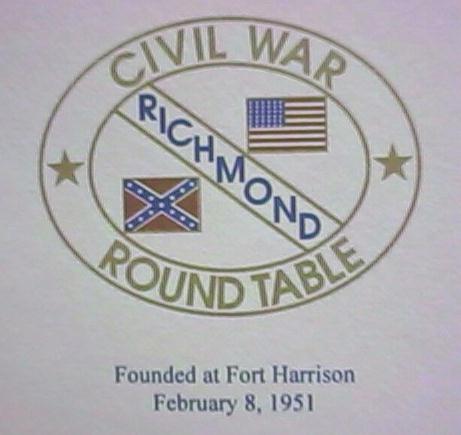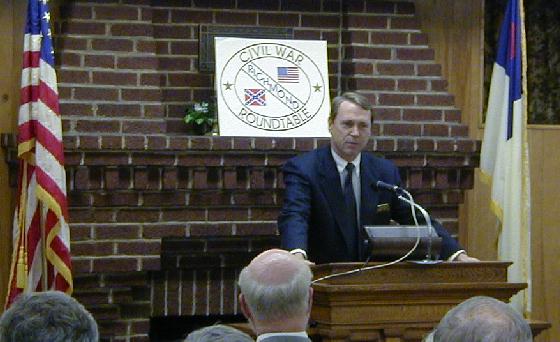


December 2000
R.Danny Witt, President Art & Carol Bergeron, Editors 5500 Ashton Park Way 3901 Paces Ferry Road Glen Allen, VA 23059 Chester, VA 23831-1239 December 2000 PROGRAM Edwin C. Bearss "Raising of the U.S.S. Cairo" 8:00 p.m., Tuesday, December 12, 2000, at the Holiday Inn-Crossroads, 2000 Staples Mill Road 6 p.m. Social Hour; 7 p.m. Dinner Edwin Cole Bearss is Historian Emeritus for the National Park Service. A native of Billings, Montana, he received his bachelor's degree at Georgetown University and his master's degree at Indiana University. He was Chief Historian of the National Park Service from November 1981 to July 1994. Then Bearss became the Special Assistant to the National Park Service Director for Civil War Sites. During his early park service career, Bearss was attached to the Southeast Regional Office, which then had its headquarters in Richmond. He is a prolific author, and his books include Hardluck Ironclad: The Sinking and Salvage of the Cairo (1966); The Campaign for Vicksburg (3 vols., 1985-1986); and Forrest at Brice's Cross Roads and in North Mississippi in 1864 (1979). Bearss is also one of the most popular speakers and tour guides in the country. The U.S.S. Cairo was one of seven ironclad gunboats named in honor of towns along the upper Mississippi and Ohio rivers. She was constructed at Mound City, Illinois, and commissioned in January 1862. On the morning of December 12, 1862, her commander led a small flotilla up the Yazoo River, north of Vicksburg, to destroy Confederate batteries and clear the channel of torpedoes. As the Cairo reached a point seven miles north of Vicksburg, she was rocked by two explosions in quick succession which tore gaping holes in the ship's hull. Within twelve minutes the ironclad sank without any loss of life. Cairo became the first ship in history to be sunk by an electrically detonated torpedo. Over the years the gunboat was soon forgotten, and her watery grave was slowly covered by a shroud of silt and sand. By studying contemporary documents and maps, Bearss, who was then Historian at Vicksburg National Military Park, was able to plot the approximate site of the wreck. In December 1964, the ironclad was finally pulled from the river and eventually taken to the Ingalls Shipyard in Pascagoula, Mississippi, for repair and conservation. The vessel was transported to the park and partially reconstructed on a concrete foundation near the Vicksburg National Cemetery in June 1977.
Review of the November Program Professor Craig L. Symonds presented an interesting and informative talk on "Franklin Buchanan and the Battle of Hampton Roads." Born in Baltimore, Maryland, in 1800, Buchanan had a distinguished career in the United States navy prior to the Civil War. Known affectionately as "Old Buck," he was the first superintendent of the U. S. Naval Academy. He was a typical naval officer of his time-ambitious and enthusiastic and a fighter. In 1859, Buchanan was a captain and commander of the Washington Navy Yard, one of the most prestigious positions in the naval service. He faced a personal crisis in 1861. Despite his 45 years in the navy, he believed in states' rights. When Union troops fired on civilians in Baltimore, Buchanan resigned his commission. Maryland did not secede, and he attempted to get back into the navy. Secretary Gideon Welles refused to allow this, and Buchanan then offered his services to the Confederacy. In Richmond, Buchanan was given command of the C. S. S. Virginia and the James River Squadron. Confederate Secretary of the Navy Stephen R. Mallory wanted a bold, judicious individual to command the new ironclad and hoped that Buchanan would be able to take her up the Potomac River and attack Washington, D. C. However, Old Buck discovered that the Virginia's engines were incapable of such an undertaking. He assumed command at Norfolk on March 4, 1862, and decided to attack the Union warships in Hampton Roads. Buchanan had wanted Major General John B. Magruder to cooperate with the attack by sending his army against the Union land forces nearby, but Magruder refused because his force was too weak. A surprise movement by the Virginia was impossible, so on the morning of March 8, Buchanan took her down the Elizabeth River to take on the enemy vessels. The ironclad's crew had coated the casemate with wax to help deflect Federal shells. Buchanan had his ship steam toward the frigates Cumberland and Congress. The two warships carried 70 guns, while the Virginia had only 10. Because the Cumberland had the strongest armament, the Virginia would go after her first, intending to ram and sink her. Then the ironclad would attack the Congress, on which Buchanan's brother served as paymaster. The Virginia received a salvo from the Cumberland as she approached, but none of the shots even dented the iron on her casemate. Buchanan ordered his forward gun to fire when the Virginia's ram drove into the Cumberland. This would help his vessel back out. Unfortunately, the 1,500-pound ram became stuck in the Cumberland's side. Just as it appeared that the latter would sink and take her attacker with her, the ram broke off. The Virginia was able to get away and turn toward the Congress. Buchanan watched as the commander of the Congress took his ship into shallow water. Old Buck ordered his men to pour a heavy fire into the Union warship. After a short time, the Federals ran up several white flags. Buchanan sent one of his support vessels to receive the surrender of the Congress. While doing so, Union troops ashore began firing on the Confederates, forcing them to retreat before the surrender could be completed. Buchanan was unaware of what had happened and ordered his crew to fire into the Congress with hot shot. This fusillade set the Federal ship afire, and she blew up a few minutes past midnight. Toward the end of the day, the Virginia fired a few broadsides at the remaining enemy warship, the Minnesota. Buchanan received a severe leg wound during the Battle of Hampton Roads and had to turn over command of the Virginia to Catesby Jones. Thus Buchanan missed the battle fought the following day with the Monitor. He did receive promotion to full admiral, the only man to hold such rank during the war.
Richmond Civil War Round Table Membership Dues are Due
Dues received after this date will be returned to the sender. Ex-members may reapply for membership and will be placed on the waiting list for reacceptance a year later into the 2002 membership. Dues are to be sent in check form only to: Gus Faeder, RCWRT Treasurer 10207 Salem Oaks Place Richmond, VA 23237 Please include the bottom portion of this form with your check for membership dues. This information will be used on the roster and newsletter mailing list. Check No._______________(record keeping information only) Your Name___________________________________________________ Address_____________________________________________________ Telephone [home] (___)____-_______ [work] (___)____-________ Please check the membership category for which you are making a payment: ___ $25.00 Resident Member (individual) ___ $35.00 Resident Couple members (husband & wife) ___ $10.00 Non-Resident Member (individual) - defined as a member living 50 miles outside of Richmond. ___ $15.00 Non-Resident Couple members (husband & wife) - defined as members living 50 miles outside of Richmond. ___ $10.00 Senior Member (individual) - defined as a member who is 65 years of age with 10 years of RCWRT membership. ___ Are you 65 years or older? ___ Have you been an active member since 1990? A "yes" answer to both questions qualifies you for this membership category. ___ $15.00 Senior Couple Members (husband & wife) - defined as members who are 65 years of age with 10 years of joint RCWRT membership. ___ Are both of you 65 years or older? ___ Have you had joint membership since 1990? A "yes" answer to both questions qualifies you for this membership category.
Announcements
At the November meeting, the three following past presidents were elected to the 2001 Executive Committee-Jack Ackerly, Daniel Balfour, and Robert (Bobby) E. L. Krick.
A Civil War Christmas Recipe The following recipe for eggnog is from The Civil War Cookbook by William C. "Jack" Davis (1993): 4 egg yolks 4 Tbsps sugar 1 cup cream (whipping) 1 cup brandy 1/4 cup wine 4 egg whites A little grated nutmeg Beat the egg yolks until light then slowly beat in the sugar, cream, brandy and wine. Whip the egg whites separately and then fold into the other ingredients. Sprinkle with the nutmeg to serve.
NEW URL! Richmond Civil War Round Table in Cyberspace. The Round Table's Web site has been available for several months. It includes the monthly newsletter, CW book reports, photographs of previous meetings, and a list of all forthcoming speakers. The NEW URL or Web address is: www.rcwrt.org or just rcwrt.org
Richmond Civil War Round Table Newsletter Art & Carol Bergeron, Editors 3901 Paces Ferry Road Chester, VA 23831-1239
Return to News Letters Index
Return to main page

©R.C.W.R.T. 2000
